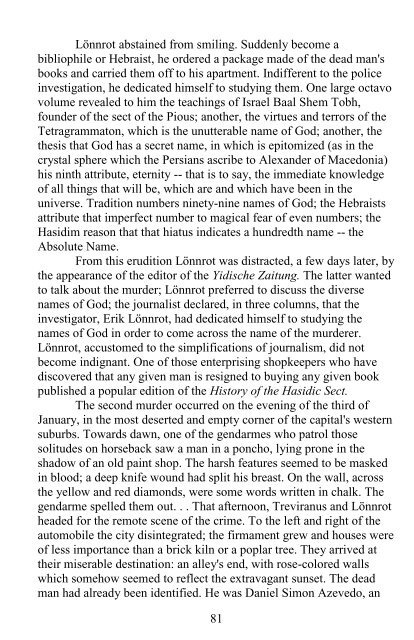Jorge Luis Borges - Labyrinths
Jorge Luis Borges - Labyrinths
Jorge Luis Borges - Labyrinths
You also want an ePaper? Increase the reach of your titles
YUMPU automatically turns print PDFs into web optimized ePapers that Google loves.
Lönnrot abstained from smiling. Suddenly become a<br />
bibliophile or Hebraist, he ordered a package made of the dead man's<br />
books and carried them off to his apartment. Indifferent to the police<br />
investigation, he dedicated himself to studying them. One large octavo<br />
volume revealed to him the teachings of Israel Baal Shem Tobh,<br />
founder of the sect of the Pious; another, the virtues and terrors of the<br />
Tetragrammaton, which is the unutterable name of God; another, the<br />
thesis that God has a secret name, in which is epitomized (as in the<br />
crystal sphere which the Persians ascribe to Alexander of Macedonia)<br />
his ninth attribute, eternity -- that is to say, the immediate knowledge<br />
of all things that will be, which are and which have been in the<br />
universe. Tradition numbers ninety-nine names of God; the Hebraists<br />
attribute that imperfect number to magical fear of even numbers; the<br />
Hasidim reason that that hiatus indicates a hundredth name -- the<br />
Absolute Name.<br />
From this erudition Lönnrot was distracted, a few days later, by<br />
the appearance of the editor of the Yidische Zaitung. The latter wanted<br />
to talk about the murder; Lönnrot preferred to discuss the diverse<br />
names of God; the journalist declared, in three columns, that the<br />
investigator, Erik Lönnrot, had dedicated himself to studying the<br />
names of God in order to come across the name of the murderer.<br />
Lönnrot, accustomed to the simplifications of journalism, did not<br />
become indignant. One of those enterprising shopkeepers who have<br />
discovered that any given man is resigned to buying any given book<br />
published a popular edition of the History of the Hasidic Sect.<br />
The second murder occurred on the evening of the third of<br />
January, in the most deserted and empty corner of the capital's western<br />
suburbs. Towards dawn, one of the gendarmes who patrol those<br />
solitudes on horseback saw a man in a poncho, lying prone in the<br />
shadow of an old paint shop. The harsh features seemed to be masked<br />
in blood; a deep knife wound had split his breast. On the wall, across<br />
the yellow and red diamonds, were some words written in chalk. The<br />
gendarme spelled them out. . . That afternoon, Treviranus and Lönnrot<br />
headed for the remote scene of the crime. To the left and right of the<br />
automobile the city disintegrated; the firmament grew and houses were<br />
of less importance than a brick kiln or a poplar tree. They arrived at<br />
their miserable destination: an alley's end, with rose-colored walls<br />
which somehow seemed to reflect the extravagant sunset. The dead<br />
man had already been identified. He was Daniel Simon Azevedo, an<br />
81


